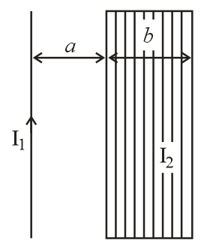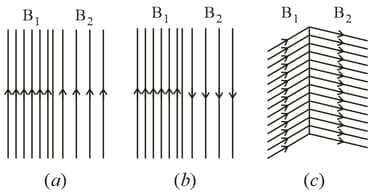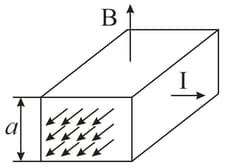A square frame carrying a current is located in the same plane as a long straight wire carrying a current . The frame side has a length . The axis of the frame passing through the midpoints of opposite sides is parallel to the wire and is separated from it by the distance which is times greater than the side of the frame. Find,
ampere force acting on the frame,
the mechanical work to be performed in order to turn the frame through about its axis, with the currents maintained constant.
(Permeability of vacuum, )
the mechanical work to be performed in order to turn the frame through about its axis, with the currents maintained constant.

Important Questions on ELECTRODYNAMICS
A direct current flows in a long straight conductor, whose cross-section has the form of a thin half-ring of radius . The same current flows in the opposite direction, along a thin conductor, located on the axis of the first conductor (point in the figure). Find the magnetic interaction force between the given conductors reduced to a unit of their length.

Two long thin parallel conductors, of the shape shown in the figure, carry direct currents and . The separation between the conductors is , the width of the right-hand conductor is equal to . With both conductors lying in one plane, find the magnetic interaction force between them, reduced to a unit of their length.

A conducting current carrying plane is placed in an external uniform magnetic field. As a result, the magnetic induction becomes equal to , on one side of the plane and to , on the other. Find the magnetic force acting per unit area of the plane, in the cases illustrated in the figure. Determine the direction of the current in the plane, in each case.

In an electromagnetic pump, designed for transferring molten metals, a pipe section with metal is located in a uniform magnetic field of induction . A current is made to flow across this pipe section, in the direction perpendicular, both to the vector and to the axis of the pipe. Find the gauge pressure produced by the pump, if and .

